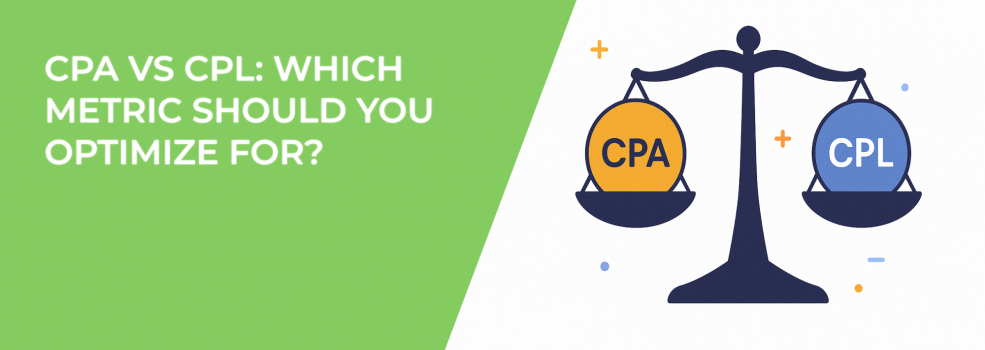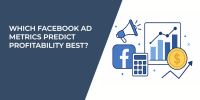Marketers often obsess over numbers — and for good reason. Ads aren’t just about reach and clicks; they’re about results. But when it comes to measuring those results, one of the most common dilemmas is this: should you focus on Cost per Acquisition (CPA) or Cost per Lead (CPL)?
On the surface, the difference seems simple. CPL tells you how much it costs to capture interest, while CPA shows what it costs to win a paying customer. But deciding which to optimize for is not always straightforward. The answer depends on your goals, your funnel, and even your industry.
Let’s take a closer look at each metric, the strengths and weaknesses behind them, and some strategies to balance both without wasting ad spend.
What Is CPA?
Cost per Acquisition (CPA) measures the cost of getting a new customer — not just a lead, but someone who takes the final step, whether that’s purchasing a product, signing a contract, or subscribing to a paid plan.
Imagine you spend $500 on ads and 10 people buy. Your CPA is $50. That $50 becomes the baseline to evaluate whether your campaigns are profitable. If your product costs $200 and your margins are healthy, the math works. If your margins are razor thin, you may need to bring the CPA down.
The power of CPA is in its clarity. You know exactly how much you’re paying for actual revenue. It strips away the guesswork of “what if these leads convert later” and grounds your campaigns in financial reality.
The drawback? It can be slow. In industries with long sales cycles — like B2B services or real estate — waiting to measure CPA might mean weeks or even months of uncertainty. This delay can make it harder to adjust campaigns in real time.
What Is CPL?
Cost per Lead (CPL) measures the cost of generating interest, usually through someone leaving their contact details: an email address, a phone number, or a form submission.
Let’s say you spend $300 and capture 60 email sign-ups. Your CPL is $5. That looks great on paper because it shows you can build a pipeline cheaply. But the story doesn’t end there. How many of those 60 people will buy? That’s where CPL can get tricky.
CPL is valuable when you need to grow awareness, test audiences, or nurture prospects over time. A solid CPL lets you know your ads are bringing in people at a price that leaves room for long-term conversions. But it’s not the final measure of success, because cheap leads that never convert are just names in a spreadsheet.
This is why CPL often works best when paired with deeper analysis — tracking not just how many leads you generate, but how many of them eventually become customers.
CPA vs CPL: The Real Difference
At its core, the difference between CPA and CPL is about timing. CPL measures the efficiency of the first step, while CPA measures the efficiency of the last step.
Think of your funnel as a journey:
-
CPL measures how much it costs to get someone to stop and say, “I’m interested.”
-
CPA measures how much it costs to get them to cross the finish line and buy.
Both metrics are useful, but they tell different stories. If you only track CPL, you risk thinking your ads are working when they’re not. If you only track CPA, you might miss opportunities to fill your funnel with future buyers.
When to Focus on CPL
CPL is a better focus when you’re in growth mode, building a customer pipeline, or testing new markets. It’s especially important in industries where buyers don’t make immediate decisions.
For example, a B2B software company may run lead-generation campaigns offering free demos or whitepapers. The goal isn’t to close a deal overnight, but to get qualified leads into the funnel so sales teams can nurture them. In this case, CPL becomes the metric that shows whether those campaigns are sustainable.
How to make CPL optimization work better:
-
Offer something of real value in exchange for contact info — free trials, useful guides, or exclusive offers.
-
Keep forms simple. Fewer fields usually mean more leads, though you can experiment with qualification questions if lead quality is an issue.
-
Don’t just measure volume; track lead quality. Tagging and segmenting leads helps identify which campaigns generate the best prospects.
-
Retarget leads quickly. The fresher the interest, the higher the chance of conversion down the line.
When CPL is your focus, remember that the quality of leads matters just as much as the cost. A $20 lead who becomes a customer is worth far more than five $3 leads who never buy.
When to Focus on CPA
CPA becomes your north star when conversions are immediate or when your funnel is already proven. E-commerce brands, mobile apps, and subscription services often find CPA more practical because they can measure sales within days, not months.
For instance, if you sell a $50 product online and your CPA is $25, you know you’re getting customers at a sustainable cost. Optimizing toward CPA ensures your ad spend directly drives profit.
How to improve CPA performance:
-
Use retargeting ads for people who visited your site but didn’t purchase — they’re already warm prospects. You can also learn how to set up powerful retargeting campaigns in our guide How to Set Up Facebook Retargeting.
-
Test lookalike audiences based on past buyers. This narrows targeting to people more likely to convert.
-
Optimize landing pages for conversions, not just traffic. A slow or confusing checkout page can inflate your CPA.
-
Review your attribution windows. If buyers often take a week to decide, set up tracking that captures those delayed purchases.
Optimizing for CPA keeps your campaigns grounded in results that impact the bottom line. But it does require patience, data, and a clear understanding of customer behavior.
The Pitfalls of Over-Focusing on One Metric
A lot of advertisers fall into the trap of chasing only one number.
-
If you chase only CPL, you may end up with thousands of leads who never buy.
-
If you chase only CPA, you might cut off the flow of future customers and hurt long-term growth.
The best marketers step back and look at the funnel as a whole. They ask: Are we bringing in enough quality leads at a good price? And are those leads converting into customers at a sustainable cost?
Balancing CPL and CPA requires discipline, but it prevents short-term wins from hiding long-term weaknesses.
How to Balance CPA and CPL
So how do you balance both without wasting budget? Here are a few practical approaches:
-
Track the entire journey. Don’t stop at the first conversion. Follow leads all the way to purchase to see the real cost of acquisition.
-
Run dual campaigns. Test campaigns optimized for leads alongside campaigns optimized for sales. Compare not only short-term results but also lifetime value.
-
Adjust goals by stage. Early in a product launch, CPL might be your focus. Once you’ve built awareness and warmed up your audience, shift toward CPA.
-
Continuously refine. Test creatives, adjust offers, and revisit landing pages regularly. Small changes often lower both CPL and CPA over time.
In practice, balancing these two metrics is less about chasing the lowest number and more about building a funnel that supports growth at every stage.
To get the most value from each lead, it helps to start with precise targeting. Our article Facebook Ad Targeting 101: How to Reach the Right Audience walks you through the basics.
Which Metric Should You Optimize For?
There’s no single right answer. The better question is: what’s the goal of your campaign right now?
-
If your priority is building a pipeline and nurturing future customers, CPL should guide you.
-
If your priority is revenue and proving ROI quickly, CPA is the metric to optimize for.
-
If you want sustainable growth, track both.
Smart marketers don’t lock themselves into one approach forever. They stay flexible, shifting focus as campaigns evolve and business goals change.
So before launching your next campaign, pause and ask: is my funnel struggling at the top or the bottom? The answer will tell you whether to prioritize CPA, CPL, or a mix of both.
For more tactics on filling the funnel, read Mastering Lead Generation in 2025: Top Tactics for Success.

